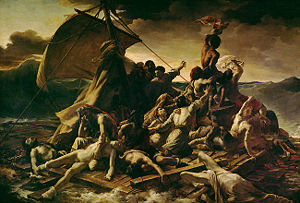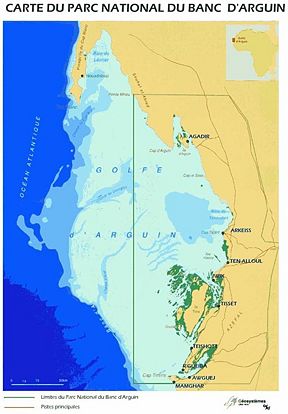Difference between revisions of "Banc d'Arguin National Park" - New World Encyclopedia
Vicki Phelps (talk | contribs) |
Vicki Phelps (talk | contribs) |
||
| Line 100: | Line 100: | ||
*[http://whc.unesco.org/en/list/506 Banc d'Arguin National Park UNESCO Site] | *[http://whc.unesco.org/en/list/506 Banc d'Arguin National Park UNESCO Site] | ||
| − | + | ||
*[http://images.google.com/images?ie=UTF-8&oe=UTF-8&sourceid=navclient&gfns=1&q=Banc%20d'Arguin%20National%20Park&sa=N&tab=wi Banc d' Arguin - Google image search results] | *[http://images.google.com/images?ie=UTF-8&oe=UTF-8&sourceid=navclient&gfns=1&q=Banc%20d'Arguin%20National%20Park&sa=N&tab=wi Banc d' Arguin - Google image search results] | ||
*[http://www.unep-wcmc.org/sites/wh/bancd%27ar.html Protected Areas Program] | *[http://www.unep-wcmc.org/sites/wh/bancd%27ar.html Protected Areas Program] | ||
Revision as of 18:43, 2 January 2009
| Banc d'Arguin National Park* | |
|---|---|
| UNESCO World Heritage Site | |
| State Party | |
| Type | Natural |
| Criteria | ix, x |
| Reference | 506 |
| Region** | Arab States |
| Inscription history | |
| Inscription | 1989 (13th Session) |
| * Name as inscribed on World Heritage List. ** Region as classified by UNESCO. | |
| Banc d'Arguin National Park | |
|---|---|
| IUCN Category VI (Managed Resource Protected Area) | |
| | |
| Location: | Mauritania |
| Nearest city: | Nouakchott and Nouadhibou |
| Area: | 12,000 km² |
| Established: | 1978 |
| Governing body: | IUCN |
The Banc d'Arguin National Park lies on the west coast of Mauritania between Nouakchott and Nouadhibou. Fringing the Atlantic coast, the park comprises sand dunes, coastal swamps, small islands, and shallow coastal waters. The contrast between the harsh desert environment inland and the biodiversity of the marine zone has resulted in a land- and seascape of outstanding natural significance.
This World Heritage Site is a major breeding site for migratory birds. A wide range of species include flamingos, broad-billed sandpipers, pelicans, and terns. Much of the breeding is on sand banks, including the islands of Tidra, Niroumi, Nair, Kijji, and Arguim. The surrounding waters are some of the richest fishing waters in western Africa and serve as nesting grounds for the entire western region.
The Banc d'Arguin National Park was established to protect both the natural resources and the valuable fisheries, which makes a significant contribution to the national economy, as well as scientifically and aesthetically valuable geological sites.
The park's vast expanses of mudflats provide a home for over two million migrant shorebirds from northern Europe, Siberia, and Greenland. The region's mild climate and absence of human disturbance makes the park one of the most important sites in the world for these species. The nesting bird population is also noted for its great numbers and diversity—between 25,000 and 40,000 pairs belonging to 15 species—making the largest colonies of water birds in West Africa.
La Méduse was a French frigate that infamously sunk off the Bank of Arguin in 1816. The scene was the subject of a painting by Théodore Géricault called "The Raft of the Medusa," which is displayed in the Louvre Museum in Paris, France.
Geography
Battering surf and shifting sand banks characterize the entire length of the shoreline. The Ras Nouadhibou (formerly Cap Blanc) peninsula, which forms Dakhlet Nouadhibou (formerly Lévrier Bay) to the east, is fifty kilometers long and up to thirteen kilometers wide. The peninsula is administratively divided between Western Sahara and Mauritania, with the Mauritanian port and railhead of Nouadhibou located on the eastern shore. Dakhlet Nouadhibou, one of the largest natural harbors on the west coast of Africa, is forty-three kilometers long and thirty-two kilometers wide at its broadest point. Fifty kilometers southeast of Ras Nouadhibou is Arguin. In 1455 the first Portuguese installation south of Cape Bojador (in present-day Western Sahara) was established at Arguin. Farther south is the coastline's only significant promontory, seven-meter-high Cape Timiris. From this cape to the marshy area around the mouth of the Senegal River, the coast is regular and marked only by an occasional high dune.
Climate
The Coastal Zone, or Sub-Canarian Zone, extends the length of the approximately 754-kilometer-long Atlantic coast. Prevailing oceanic trade winds from the Canary Islands modify the influence of the harmattan, producing a humid but temperate climate. Rainfall here is minimal; in Nouadhibou it averages less than three centimeters annually and occurs between July and September. Temperatures are moderate, varying from mean maximums of 28°C and 32°C for Nouadhibou and Nouakchott, respectively, to mean minimums of 16°C and 19°C.
Fauna
The park is host to one of the world's most diversified communities of nesting piscivorous birds in the world. At least 108 bird species have been recorded, representing both Palaearctic and Afrotropical realms. Wintering shorebirds number over three million and include hundreds of thousands of black tern (Chlidonias nigra) and flamingo {Phoenocopterus ruber), ringed plover (Charadrius hiaticula), grey plover (Pluvialis squatarola), knot (Calidris canutus), redshank (Tringa totanus) and bar-tailed godwit (Limosa lapponica).
The area is one of the most important wintering grounds for European spoonbill (Platalea leucorodia leucorodia). Breeding birds include white pelican (Pelecanus onocrotalus), reed cormorant (Phalacrocorax africanus), gull-billed tern (Gelochelidon nilotica), Caspian tern (Hydroprogne caspian), royal tern (Sterna maxima) and common tern (Sterna hirundo), together with several species or subspecies with an African distribution, such as endemic heron (Ardea cinerea monicae) and spoonbill (Platalea leucorodia balsaci) and western reef heron (Egretta gularis).
Several species of sea turtle and dolphin, used by the fishermen to attract shoals of fish, can also be found.
Flora
On coastal dunes vegetation is rare. At the foot of ridges, however, large tamarisk bushes, dwarf acacias, and swallowworts may be found. Some high grass, mixed with balsam, spurge, and spiny shrubs, grows in the central region. The north has little vegetation.
History
Despite the Almoravid domination of Spain in the eleventh and twelfth centuries, there seems to be little evidence of contact during that time between Mauritania and Europe. The inhospitable coastline of Mauritania continued to deter voyagers until the Portuguese began their African explorations in the fifteenth century. Lured by legends of vast wealth in interior kingdoms, the Portuguese established a trading fort at Arguin, southeast of Cap Blanc (present-day Ras Nouadhibou), in 1455. The king of Portugal also maintained a commercial agent at Ouadane in the Adrar in an attempt to divert gold traveling north by caravan. Having only slight success in their quest for gold, the Portuguese quickly adapted to dealing in slaves. In the mid fifteenth century, as many as 1,000 slaves per year were exported from Arguin to Europe and to the Portuguese sugar plantations on the island of Sáo Tomé in the Gulf of Guinea.

|
| The Raft of the Medusa |
| Théodore Géricault, 1818–19 |
| Oil on canvas |
| 491 × 717 cm, 193.3 × 282.3 in |
| Musée du Louvre, Paris |
Because of its rich fishery and strategic location, the territory was highly coveted and disputed by the European colonial powers of Portugal, France, England, Prussia/Germany, and the Netherlands.
- Arguin Island
1445 - Feb. 5, 1633 Portuguese rule (Arguim).
Feb. 5, 1633 - 1678 Dutch rule (brief English occupation in 1665).
Sept. 1, 1678 - Sept. 1678 French occupation.
September 1678 - Abandoned.
Oct. 5, 1685 - Mar. 7, 1721 Brandenburg (from 1701, Prussian) rule.
Mar. 7, 1721 - Jan. 11, 1722 French rule.
Jan. 11, 1722 - Feb. 20, 1724 Dutch rule.
Feb. 20, 1724 - Mar. 1728 French rule.
With the merger of the Portuguese and Spanish crowns in 1580, the Spaniards became the dominant influence along the coast. In 1633, however, they were replaced by the Dutch, who were the first to begin exploiting the gum arabic trade. Produced by the acacia trees of Trarza and Brakna and used in textile pattern printing, this gum arabic was considered superior to that previously obtained in Arabia. By 1678 the French had driven out the Dutch and established a permanent settlement at Saint Louis at the mouth of the Senegal River, where the French Company of the Senegal River had been trading for more than fifty years.
The Maures (Moors), with whom the Europeans were trading, considered the constant rivalries between European powers a sign of weakness, and they quickly learned the benefits of playing one power against another. For example, they agreed to give monopolies to both the French and the Dutch. The Maures also took advantage of the Europeans whenever possible, so that when the French negotiated with the amir of Trarza to secure a monopoly on the gum Arabic trade, the amir in exchange demanded a considerable number of gifts. Thus began the custom of the Maures expecting an annual payment for doing business with a government or a company. By 1763 the British had expelled France from the West African coast, and France recovered control only when the Congress of Vienna in 1815 recognized French sovereignty over the coast of West Africa from Cap Blanc south to Senegal.
Demographics
The local population comprises about 500 or so Imraguen tribesmen who live in seven villages within the park. They base their economy on subsistence fishing using traditional methods.
Conservation
Although the park was constituted as a way to protect its environment, overfishing by international fleets in the waters just off Banc d'Arguin, outside the park, is depleting fish resources and may cause a decline of the breeding colonies of fish-eating bird species.
In 2006 Mauritania sold fishing rights to the EU in exchange for external debt reduction, prompting arguments of overfishing, sustainability, neocolonialism, and the rights of local people.[1]
External links
- Banc d' Arguin - Google image search results
- Protected Areas Program
- World Conservation Union
- Google Earth - Banc d'Arguin National Park - Bookmark & Site Borders
- US Library of Congress - Country Studies
Credits
New World Encyclopedia writers and editors rewrote and completed the Wikipedia article in accordance with New World Encyclopedia standards. This article abides by terms of the Creative Commons CC-by-sa 3.0 License (CC-by-sa), which may be used and disseminated with proper attribution. Credit is due under the terms of this license that can reference both the New World Encyclopedia contributors and the selfless volunteer contributors of the Wikimedia Foundation. To cite this article click here for a list of acceptable citing formats.The history of earlier contributions by wikipedians is accessible to researchers here:
The history of this article since it was imported to New World Encyclopedia:
Note: Some restrictions may apply to use of individual images which are separately licensed.
